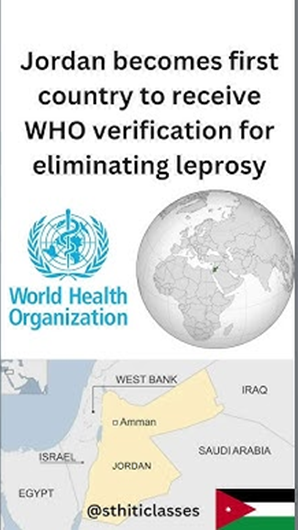- Courses
- GS Full Course 1 Year
- GS Full Course 2 Year
- GS Full Course 3 Year
- GS Full Course Till Selection
- Online Program
- GS Recorded Course
- NCERT (Recorded 500+ Hours)
- Polity Recorded Course
- Geography Recorded Course
- Economy Recorded Course
- AMAC Recorded Course
- Modern India, Post Independence & World History
- Environment Recoded Course
- Governance Recoded Course
- Science & Tech. Recoded Course
- International Relations and Internal Security Recorded Course
- Disaster Management Module Course
- Ethics Recoded Course
- Essay Recoded Course
- Current Affairs Recoded Course
- CSAT
- 5 LAYERED ARJUNA Mentorship
- Public Administration Optional
- ABOUT US
- OUR TOPPERS
- TEST SERIES
- FREE STUDY MATERIAL
- VIDEOS
- CONTACT US
Jordan Becomes the 1st Country to Eliminate Leprosy
Jordan Becomes the 1st Country to Eliminate Leprosy

In September 2024, Jordan became the first country to eliminate leprosy, receiving official verification from the World Health Organization (WHO). This achievement shows Jordan's commitment to eradicating leprosy, a disease that has afflicted humanity for centuries.
Overview of Leprosy
- Leprosy, or Hansen’s disease, is a chronic infectious disease caused by the bacterium Mycobacterium leprae. It primarily affects the skin, nerves, and respiratory tract.
- Though curable, leprosy has historically been associated with social stigma, leading to the ostracism of those affected.
- Despite significant advancements in medical treatment, over 200,000 new cases are diagnosed annually worldwide, particularly in regions with limited healthcare access.
Jordan’s Path to Elimination: Key Strategies and Interventions
Jordan's journey towards eliminating leprosy involved a comprehensive approach characterized by:
-
Public Health Campaigns:
- Targeted campaigns aimed at educating communities about leprosy's curability and reducing stigma.
- Emphasis on early detection and treatment to prevent complications and promote timely intervention.
-
Access to Treatment:
- Implementation of multi-drug therapy (MDT), a combination of antibiotics proven effective against leprosy.
- Provision of free treatment to all citizens through the public healthcare system.
-
Training of Healthcare Workers:
- Training programs to equip health workers with skills to identify early symptoms of leprosy and administer appropriate treatment.
- Ensuring healthcare personnel were available in even the most remote areas to facilitate access.
-
Surveillance Systems:
- Establishing robust systems to monitor and track leprosy cases, ensuring isolated cases were effectively managed.
- Continuous monitoring of trends to identify any resurgence of the disease.
-
Community Reintegration Programs:
- Developing initiatives to assist those cured of leprosy in reintegrating into society.
- Providing vocational training and psychological support to overcome social barriers.
WHO Verification Process:
The WHO's verification process for leprosy elimination is stringent and involves:
- A requirement that the prevalence of leprosy falls below 1 case per 10,000 population.
- Evidence of effective systems for detecting, treating, and preventing the disease.
- Jordan not only met these criteria but exceeded them, showcasing a commitment to healthcare equity.
Global Implications
- Jordan’s success serves as a precedent for other countries grappling with leprosy, particularly in regions where healthcare access and social stigma remain challenges.
- The WHO prioritizes leprosy elimination globally, and Jordan's achievement may catalyze efforts in other nations, providing a model for collaborative public health strategies.
Looking Ahead:
While Jordan celebrates this historic achievement, health officials stress the need for ongoing vigilance:
- Continued monitoring for new cases and support for affected individuals remains essential.
- Jordan's success highlights the importance of commitment, collaboration, and determination in overcoming public health challenges.
- The milestone marks a new chapter in the global fight against leprosy, positioning Jordan as a leader in the pursuit of a future free from this ancient disease.
What is Leprosy?
Leprosy is caused by the slow-growing bacterium Mycobacterium leprae. It has a long incubation period, with symptoms potentially appearing five to 20 years after infection.
|
|
Leprosy |
|
Cause |
Mycobacterium leprae bacteria |
|
Symptoms |
Skin lesions, loss of sensation, numbness, ulcers, and more |
|
Transmission |
Droplets from the nose and mouth of an untreated person |
|
Treatment |
Multi-drug therapy (MDT) with antibiotics for 6 months to a year |
|
Complications |
Permanent damage to the skin, nerves, limbs, and eyes |
|
Risk factors |
Prolonged, close contact with an untreated person |
Modern Challenges: Leprosy persists as a significant public health issue, affecting over 200,000 individuals globally each year. Despite being curable, it remains one of the most stigmatized diseases.
Historical Context
- Leprosy has been documented for thousands of years, with references dating back to 4000 BC. Historically, the disease has been misunderstood, leading to myths about its causes and transmission.
- Stigmatization has resulted in individuals being marginalized and forced to live in isolation, often in designated “leprosy colonies.”
Current Status:
- According to the WHO, 202,185 new leprosy cases were reported globally in 2019, with India, Brazil, and Indonesia accounting for the majority.
- Leprosy is entirely treatable with multi-drug therapy (MDT), yet misconceptions and stigma continue to impede eradication efforts.
Conclusion
Jordan’s verification as the first country to eliminate leprosy marks a significant achievement in global health. By addressing both medical and social aspects of the disease, Jordan has set a standard for other nations to follow. This success story emphasizes the potential for collaborative efforts and innovative strategies to tackle public health challenges, reaffirming the belief that with commitment and cooperation, diseases once deemed insurmountable can be eradicated.
Must Check: Best IAS Coaching In Delhi
UPSC Prelims Result 2024 Out: Expected Cut Off & Other Details, UPSC Prelims 2024 Answer with Explanation, Daily Prelims Quiz, Daily Current Affairs, MONTHLY CURRENT AFFAIRS TOTAL (CAT) MAGAZINE, Best IAS Coaching Institute in Karol Bagh, Best IAS Coaching Institute in Delhi, Daily Mains Question Answer Practice, ENSURE IAS UPSC Toppers, UPSC Toppers Marksheet, Previous Year Interview Questions, UPSC Syllabus




